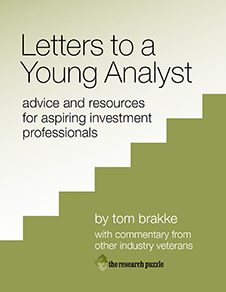
- Monday, November 16th, 2009
- all about the frame
-
In building the understanding of an investment organization that I wrote about in the last posting, it is essential to assess the framing of issues, events, processes, and goals, and to gauge whether the resulting framework is appropriate.
The firms competing for business under the Global Research Analyst Settlementthe research puzzle | This is the fifth in a series of postings on “the settlement.” This link will take you to an index of the postings on the topic that will include future postings as they are written. framed the marketing of their research as you would expect given the times (circa 2003). They positioned it in accordance with their interpretation of the regulators’ goals for the settlement and used stocks that had recently made headlines to illustrate their research acumen. This time around, that meant a clustering of sample reports that had foreseen problems with Enron and the dot-coms that had exploded.A similar clustering of examples always seems to occur. For years, if you requested a sample report, you got one for IBM; then it was Wal-Mart, then Cisco, etc. So, the first order of business is to throw away the historical frame and to try to find a forward-looking one. That is always a challenge.
If you think of the market ecosystem as a gigantic mural of activity, an investment firm (or a team within a big firm) is holding up a frame on one part of that mural and saying, “This is what we do. This is the picture I want you to view.” Some of the most interesting firms that I saw during my due diligence were those who held up very small frames, somewhat irregular ones, or those centered on parts of the mural otherwise ignored. But most providers were trying to capture a much bigger swath of the canvas.
My challenge was to reconcile that frame with the one I was developing for my settlement solution, and to constantly judge what adjustments to either would make sense. Of the famous “four Ps” of due diligence, an analysis like this concerns a firm’s philosophy and how that translates into process (the other two Ps are people and performance). The framing starts with simple breakdowns of research into type: fundamental, quantitative, and technical. Broadly speaking, the last two gave the best reads on those Enron reports, but consultants were instructed by the regulators to give “fealty” to fundamental research over quantitative research, and to exclude technical research altogether. (Another frame.)
Within each of those categories, one of the most interesting distinctions is between firms which tend to be adaptive in their approach versus those that are absolutist. As always, there are advantages and disadvantages to both (and firms are not exclusively one or the other), but to judge a research provider, you need to understand where in its decision processes it has made those choices. It is very difficult to anticipate the nature of successes and errors that a firm is likely to make without knowing it to that depth.
Of course, “framing” is now well-known as one of the investor mistakes featured in the study of behavioral finance, and so all of this talk of frames is an attempt to consciously review how decisions are made. After a due diligence meeting, I would often find I had scribbled “behavioral” next to my notes on some aspects of a firm’s operations. It indicated that I thought there was a blind spot in its approach, that it didn’t see certain ramifications. Some thoughts:
A defensiveness as to methods is usually a good tip off that there may be issues lurking. The best firms are open to new lines of thought and different views of their processes and output. Not that as an outsider I have the answers, but I’m good at moving the frame around and throwing light on new considerations. Those at firms that are thoughtful about their approaches effectively deal with questions by providing context I hadn’t considered or by gladly entering into a discussion about the relative merits of their construct versus others. Those that bristle at such lines of inquiry tend to see things in black and white, not a good way to look at the multicolored market picture.
There is no substitute for having a grounding in the investment practice of the day, but a knowledge of academic research and market history helps to put things in context. The world definitely changes, but a research process that relies on analyses whose worth looks questionable within a broader perspective is flirting with trouble. It is surprisingly common for firms (especially fundamental ones) to veer into what works short-term without seeing the developing risks.
Organizations are by definition behavioral. Choices have to be made, and how they are made may be preconceived or the result of actions that aren’t anticipated. I am reminded of a well-known firm whose pattern of analyst rating behavior evinced a striking resemblance to behavioral work on the subject as opposed to what the firm said its analysts did. In that case, I had enough statistical information to be able to pinpoint the reality and we could untangle the policies that contributed to it. Other questionable assumptions are better hidden, but trying to find them is of critical importance.
The frame that is hardest to break apart is that of past performance, with its magnetic attraction that has the power to avert the eyes from everything else. We shall try to view it clearly in the next chapter of this series.
